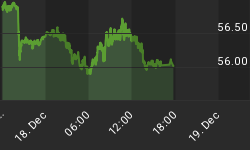Evidence Questioned Monday's Rally

After the S&P 500's 14 point gain Monday, we noted not much had changed from a weekly trend perspective. Tuesday's session reaffirmed that hypothesis. From Bloomberg:
U.S. stocks resumed a selloff, wiping out yesterday's rebound and sending benchmark indexes to the lowest levels since May, as energy shares tumbled and concern increased over escalating tensions in Ukraine. "There was a feeling among traders that yesterday's rally didn't have sustainability," Michael James, a Los Angeles-based managing director of equity trading at Wedbush Securities Inc., said in an interview. "People came in today unimpressed with yesterday's strength so we were sitting on wobbly legs even before this chatter around Ukraine came out."
Good News, Bad News
For investors, the good news is the longer-term outlook has not taken a hit yet. For example, the S&P 500 as of August 5, 2014 is shown on the right side of the image below. The present day is in much better shape than a very high risk profile market, such as the one shown on the left side from 2008. The bad news is the recent drop below the 50-day moving average (in blue) increases the odds of further corrective downside in equities. The current market has more of a "possible stock market correction" profile, rather than an "imminent bear market" profile. Keep in mind, as outlined in detail on August 1, stock market corrections can feel like a bear market. Price dropping below the 50-day is one of many examples we could cite as observable evidence of a declining tolerance for risk.

Stocks Or Bonds?
Geopolitical risks tend to be bond-friendly. The counter argument against bonds is the fear of a sooner than anticipated rate hike from the Fed. From The Wall Street Journal:
Larry Peruzzi, director of international trading at Cabrera Capital Markets, noted how quickly investors were willing to sell their stockholdings last week. "The takeaway from that is the market is fragile," he said. Some stock investors cited the potential for the Federal Reserve to raise interest rates faster than expected as weighing on the market. But that hasn't been much of an issue in the bond market. The yield on the U.S. Treasury 10-year note is actually lower than it was at the beginning of July.
The market takes all inputs into account, including Russia and the Fed. As noted on July 30, it might surprise some that despite the threat of rising rates bonds are outperforming stocks. The weekly stock vs. bond (AGG) chart below is as of the close on August 5.

Investment Implications - The Weight Of The Evidence
Regular readers know we make decisions based on hard evidence and data. The evidence began to shift back on July 25.

Since the first risk-reduction moves, the S&P 500 has dropped 58 points. Our market model called for the 4th incremental shift Tuesday to reduce portfolio risk. We continue to hold stocks (SPY), but we own less of them and have quite a bit more cash on hand. We also are holding a relatively small stake in bonds (TLT). When the market's tolerance for risk begins to improve, we are happy to redeploy our cash into growth-oriented assets. We need to see evidence of a turn. That could come at anytime...tomorrow...or in several weeks or months. Therefore, we will maintain a flexible approach while monitoring the hard evidence. The investing public demands forecasts, but staying in "the now" is a much more effective risk management approach. If you are relying on investment forecasts to protect your nest egg in the next bear market, this video covers 2008 stock market forecasts from Wall Street experts (hint: they were not helpful).















